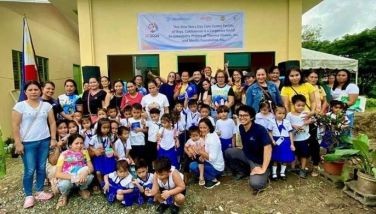Reading at 3
No, I am not talking of the program of our Department of Education to have all schoolchildren read by the time they reach Grade Three.
I am talking of a program that will make children read by the time they are Age Three.
Former Senator Nikki Coseteng, now president of the Diliman Preparatory School, recently invited me to meet advocates of the Gentle Revolution. Although I was initially sceptical of the claim that infants can read, I have to admit that the enthusiasm of the members of the nonprofit group that spearheads the Gentle Revolution, Glenn Doman’s The Institutes for the Achievement of Human Potential (IAHP), is contagious.
For those used to traditional ways of treating children, the premise is startling: babies should be taught to read from Day One. That means that, from their very first day outside the wombs of their mothers, babies should be prepared for literacy.
For the new-born, each lesson lasts exactly 15 seconds. Yes, 15 seconds. Because that is clearly not such a sacrifice (we spend a lot longer time changing diapers), parents lose nothing by using what is now known as the Doman method.
Doman developed the method, documented in the bestselling book How to Teach Your Baby to Read, decades ago. Basically, the method involves the use of flash cards, drawn especially to fit the child’s age. Because every child (not to mention every culture) is different, the flash cards are unique for each child. You cannot buy them; you have to make them.
The preparation starts while the mother is still pregnant. Making the cards is part of the education process (education starts with the parents!). After “visual differentiation” (or the way the cards are made), the parents have to choose the words that the child should learn from birth. These are words the child is likely to hear or see.
From vocabulary which comes from the family environment, the child then learns vocabulary in order to build sentences (articles, conjunctions, prepositions). By the age of three, the child should be reading a book (a children’s book with no pictures).
Only after reading a book should the child learn the alphabet. This is the most non-traditional of the steps in the Doman method. Our preschools make the big mistake of teaching the alphabet first!
Actually, as adults, if we think back to how we learned foreign languages, we can see that the method is natural. When I go to China or Japan, for instance, I have no idea what the characters on the signs mean, but I can recognize the character that says “exit.” When I went to Russia, I did not know the alphabet nor the grammar, but I knew the sound of the word that means “thank you.” Long before we learn to speak or to read, we already know how to listen and to see.
The IAHP is not really focused primarily on how children read. That is merely a side effect of what they are really doing, which is to help brain-damaged or special children. (Special children are mentally retarded, mentally deficient, cerebral palsied, epileptic, autistic, athetoid, hyperactive, attention deficit disordered, developmentally delayed, or Down Syndrome inflicted.)
The IAHP has had tremendous success with brain-damaged children. From their research and practice, for example, have come the following scientific findings: movement is the key to intelligence (e.g., children must lie on their bellies, not on their backs), modelling (parents must crawl with their children), independence (hugging should be minimized), freedom (walkers are very dangerous and damaging), and positive reinforcement (special children should never be criticized).
Their record is impressive. 85% of their blind patients were able to see and to read. 91% of deaf children were able to hear. 43% of paralyzed children were able to crawl. 99% of children unable to read were able to read (some only 8 months old).
The IAHP has extended the lessons learned from special children to well children. Since not everybody has a special child, this is the area where the IAHP findings can be very helpful. If you are about to have a baby, you might want to check out their website (iahp.org).
Be warned, however, that not everybody is convinced that the Doman method works. The American Academy of Pediatrics, for example, has repeatedly warned against certain elements of the program for special children, since there is no scientific basis for some of Doman’s prescriptions. (Doman and his associates, by the way, are medical doctors, neurologists, psychologists, physical therapists, and child brain developmentalists.) Whether visionary or lunatic, Doman can boast of his successes with special children. The debate in medical circles continues.
There is something in the entire debate that is relevant to the issue of medium of instruction in our basic education system. Both sides in the debate agree that words that have little to do with the child’s immediate environment actually harm the child’s reading ability. It is clear from medicine itself that forcing a Filipino child to read English words, when the child hears only vernacular words at home, damages the child’s brain.
Think about that for a moment. The advocates for English-only in basic education are bent on destroying the minds of an entire generation of Filipino children!
- Latest



























